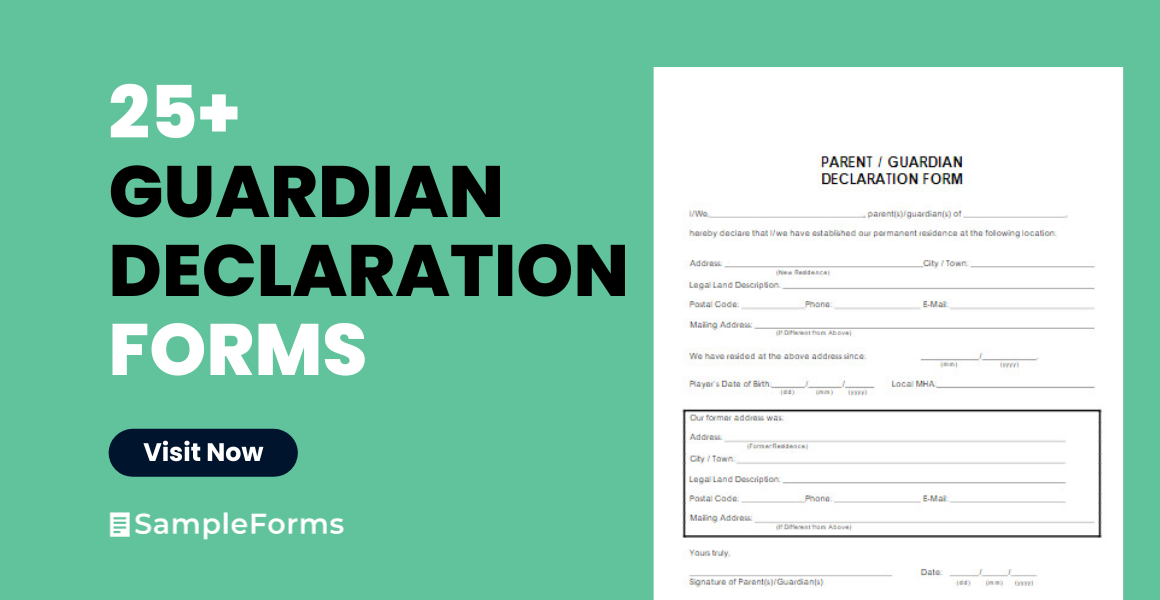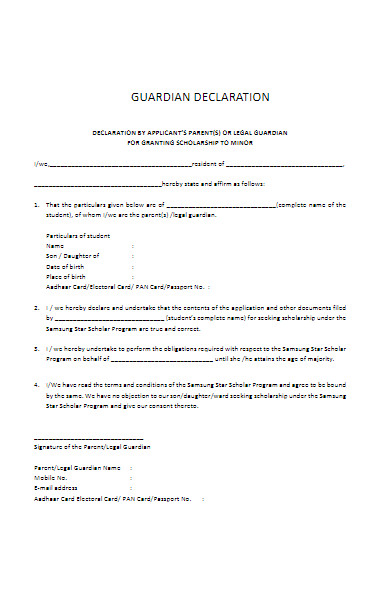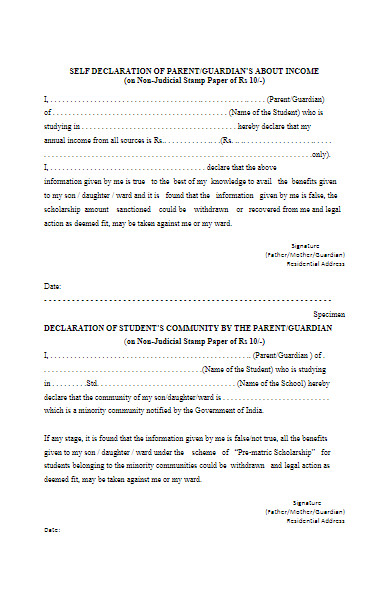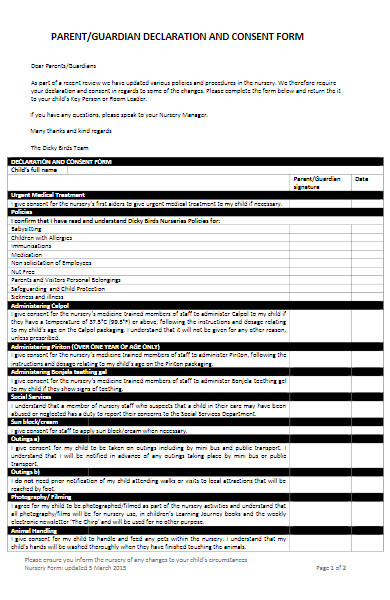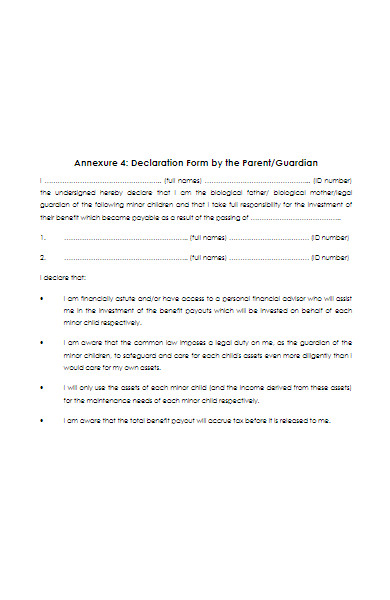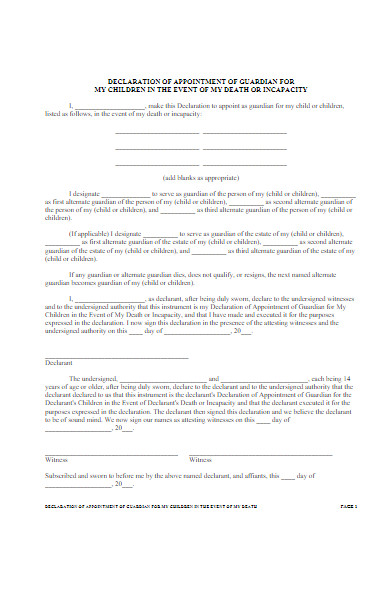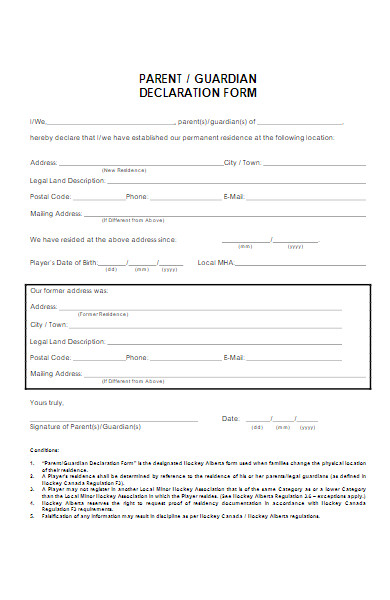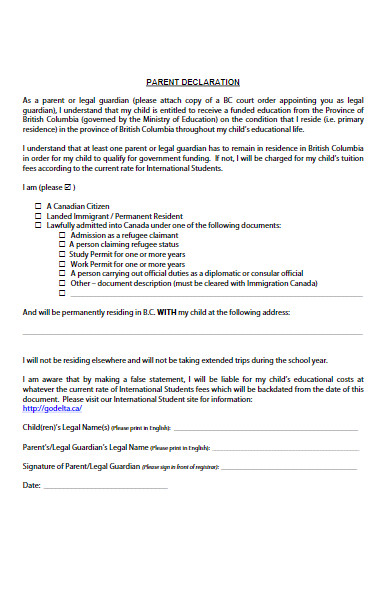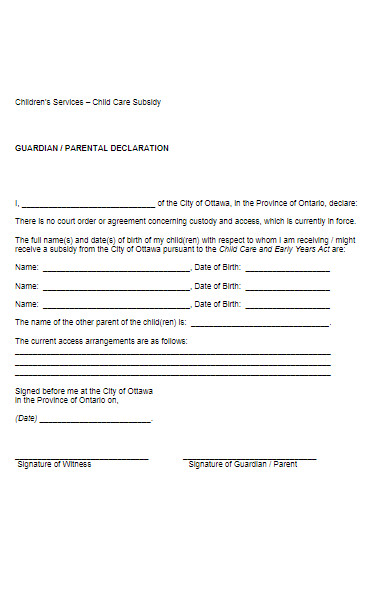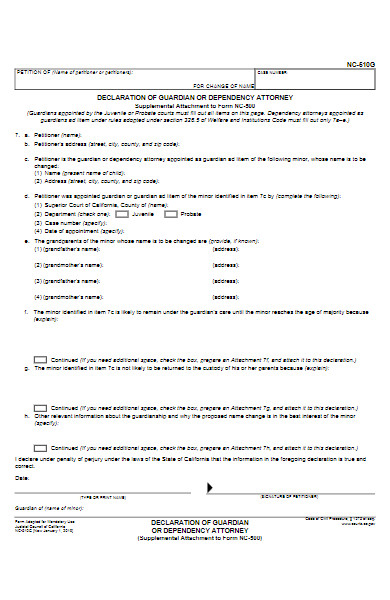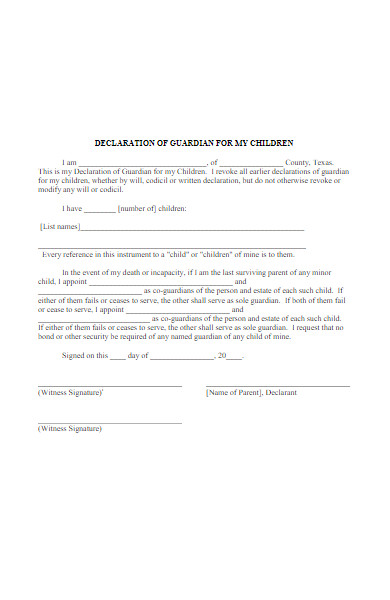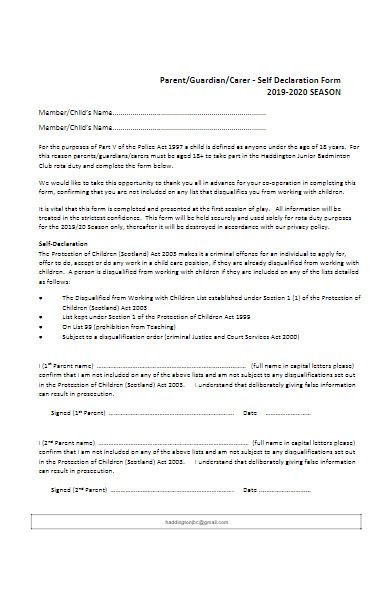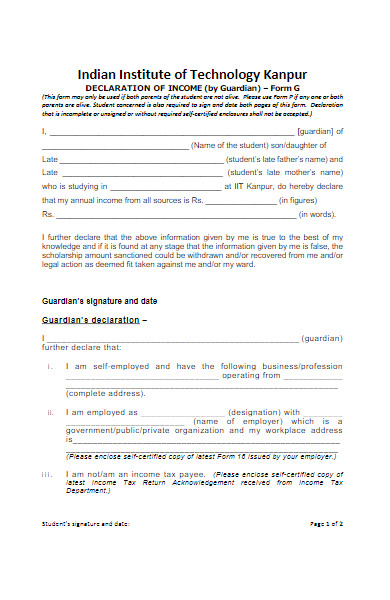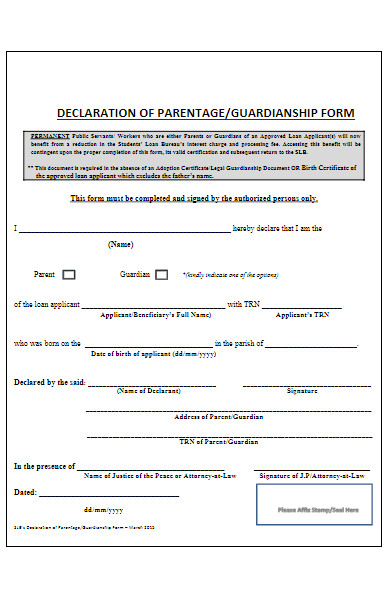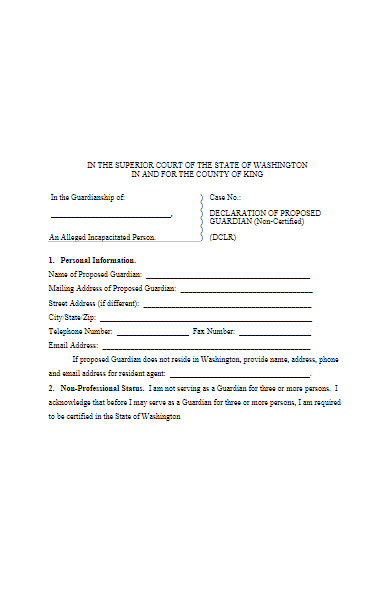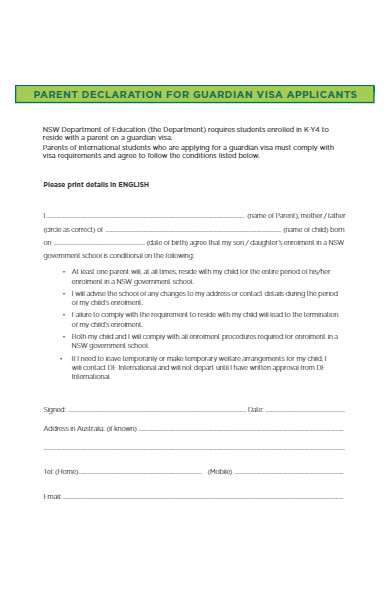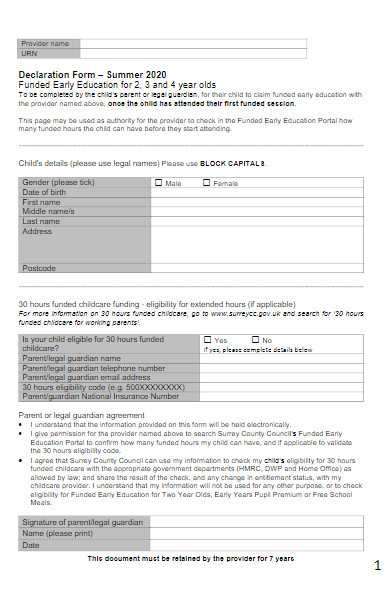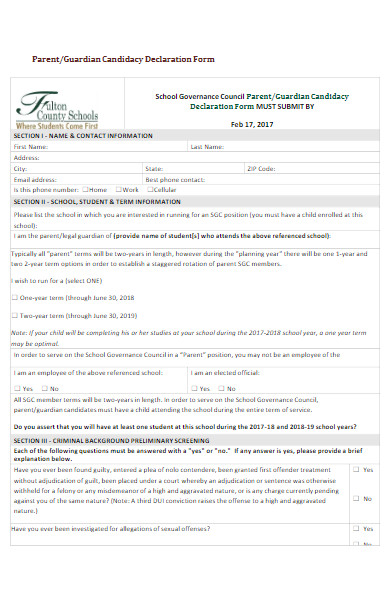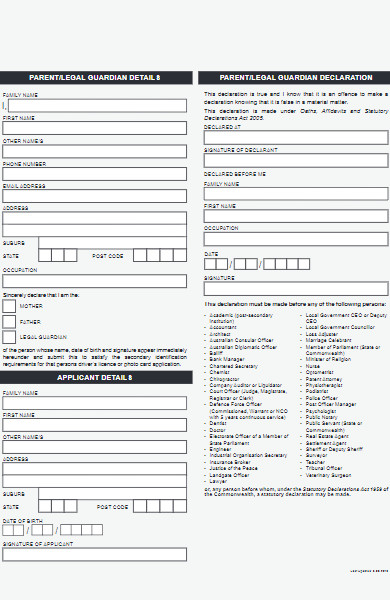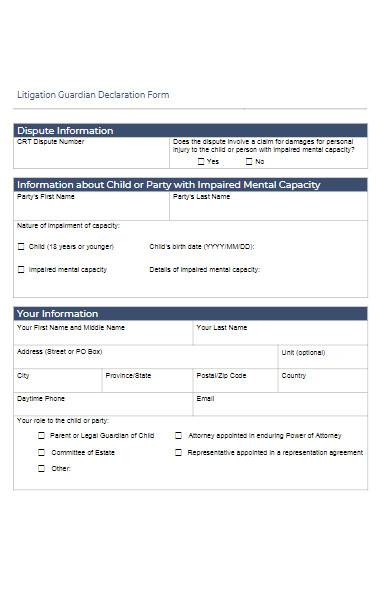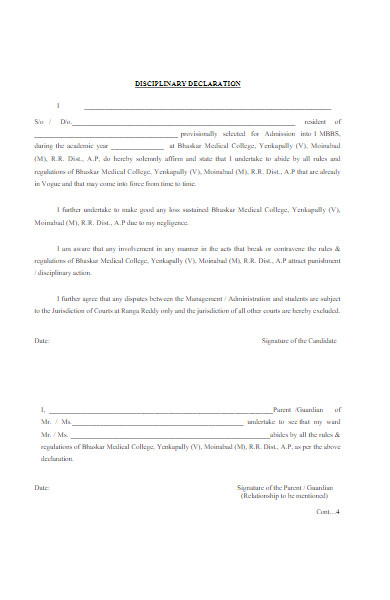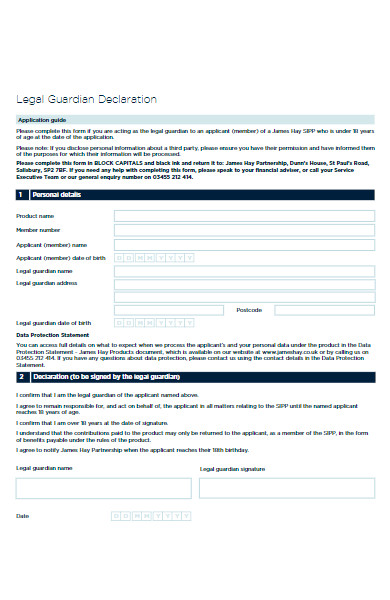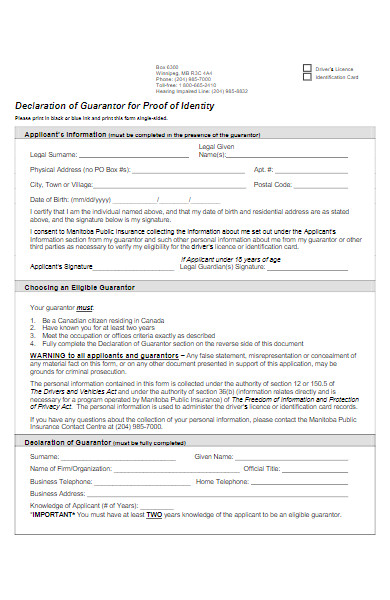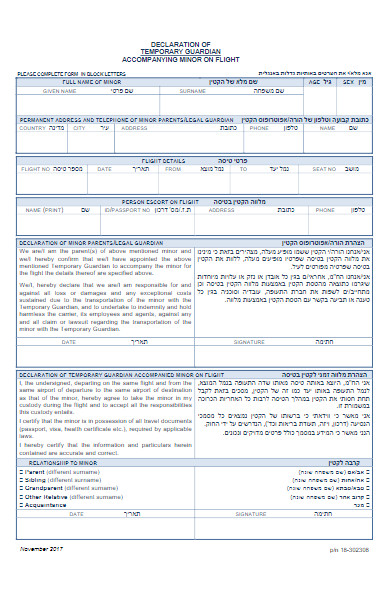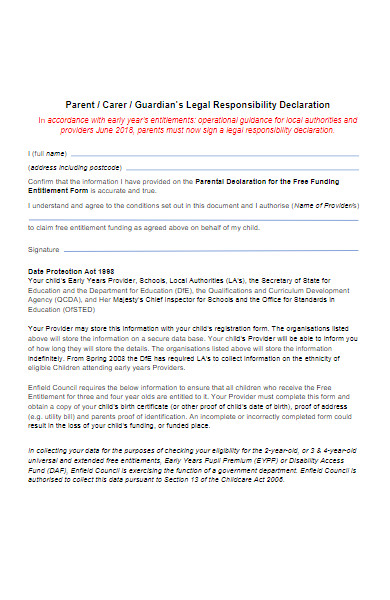A Guardian Declaration Form is a pivotal legal document that empowers individuals to make vital decisions regarding the care and custody of their minor children in the event of unforeseen circumstances. In this comprehensive guide, we delve into the meaning, types, and examples of Guardian Declaration Forms, offering valuable insights into their significance. Discover how to create this crucial document, along with essential tips to ensure your loved ones’ welfare remains secure, no matter what the future may hold.
What is a Guardian Declaration Form? – Definition
A Guardian Declaration Form, in its essence, is a legal document that allows parents to designate a guardian for their minor children in the event of their incapacity or demise. This critical document outlines the individuals or entities chosen to assume responsibility for the care, well-being, and upbringing of the children. It serves as a safeguard to ensure that, in challenging circumstances, the children’s best interests are protected, and their future remains secure under the guidance of trusted individuals or organizations.
What is the Meaning of the Guardian Declaration Form?
The meaning of a Guardian Declaration Form lies in its role as a legal document that parents or legal guardians utilize to specify their preferences for the care and custody of their minor children in case of parental incapacity or demise. This document serves as a clear expression of the parents’ wishes, ensuring that the children’s welfare remains a top priority and that a designated guardian assumes responsibility for their upbringing and well-being.
What is the Best Sample Guardian Declaration Form?
A Sample Guardian Declaration Form is a critical legal document designed to outline the wishes of parents or legal guardians concerning the care and custody of their minor children should they become unable to fulfill this role due to unforeseen circumstances. While the content of such as printable form can vary based on individual preferences and legal requirements, here is a detailed breakdown of what a comprehensive Sample Guardian Declaration Form may include:
- Title and Identification:
- A clear title indicating “Sample Guardian Declaration Form,” followed by the full names, addresses, and contact information of both parents or legal guardians.
- Declaration of Intent:
- A clear and unequivocal statement expressing the parents’ or guardians’ intent to appoint a specific individual or individuals as guardians for their minor children in case of incapacity or demise.
- Child Information:
- Detailed information about each minor child, including their full names, dates of birth, and any relevant medical or special needs.
- Primary Guardian Designation:
- Identification of the primary guardian, including their full name, address, and relationship to the children. Explanation of why this individual is chosen as the primary guardian and their willingness to accept the responsibility.
- Alternate Guardians:
- Provision for naming alternate guardians in case the primary guardian is unable or unwilling to assume the role. Include their names, addresses, and relationships to the children.
- Temporary Guardians:
- If desired, the appointment of temporary guardians who can provide immediate care and support to the children until permanent guardianship is established.
- Custody Preferences:
- Detailed preferences or restrictions related to the upbringing of the children, encompassing aspects like education, religion, healthcare, and other key considerations.
- Contact Information:
- Contact details for individuals who should be informed promptly in case of an emergency or the need to activate the guardianship arrangements.
- Witnesses and Notarization:
- Space for witnesses to sign the document, along with a section for notary public acknowledgment to ensure the form’s legal validity.
- Review and Update Procedures:
- Guidance on how and when the Sample Guardian Declaration Form should be reviewed and updated to reflect any changes in circumstances or preferences.
- Legal Counsel Recommendation:
- Encouragement for individuals to seek legal advice and consultation from an attorney specializing in family law and estate planning when completing the form to ensure its compliance with local laws and regulations.
- Signatures:
- Space for both parents or legal guardians to sign and date the document, affirming their agreement with the contents and their commitment to its execution.
While sample templates of Guardian Declaration Forms are available, it is strongly recommended that individuals consult with a qualified attorney to create a customized and legally sound document that accurately reflects their unique circumstances and adheres to relevant legal requirements. This ensures that the best interests of the children are safeguarded and the document remains legally valid. You should also take a look at our Legal Guardianship Forms.
FREE 25+ Guardian Declaration Forms in PDF
Why is a Guardian Declaration Form important?
A Guardian Declaration Form holds profound importance for several compelling reasons:
- Child Care and Protection: It serves as a safeguard for the well-being and safety of minor children, ensuring they are cared for by individuals or entities chosen by their parents or legal guardians.
- Parental Control: By designating a guardian, it empowers parents to maintain control over critical decisions regarding their children’s upbringing, even in their absence.
- Avoiding Legal Ambiguity: In the absence of such a document, courts may have to intervene to determine guardianship, potentially leading to delays, disputes, and uncertainty.
- Crisis Preparedness: It provides a proactive and concrete plan for unforeseen circumstances, such as parental incapacity, illness, or sudden death, reducing the chaos and stress for all involved.
- Consistency and Stability: It ensures continuity in a child’s life by minimizing disruptions in their living arrangements, schooling, and daily routines.
- Protecting Family Relationships: It can help prevent family conflicts and disagreements by clearly outlining parental preferences for guardianship.
- Educational and Religious Choices: Parents can express their desires for their children’s education, religious upbringing, and cultural values.
- Financial Security: It can address financial provisions to ensure that the children have the necessary resources for their upbringing.
- Legal Validity: When properly executed, it carries legal weight, making the chosen guardian’s role legally recognized and enforceable.
- Peace of Mind: It offers peace of mind to parents, knowing that their children’s future is secure and that their wishes will be respected.
- Avoiding State Intervention: Without a Guardian Declaration Form, the state may have to make decisions about guardianship, which may not align with the parents’ preferences.
- Flexibility: It provides flexibility in naming guardians, including options for temporary guardians or institutions.
In essence, a Guardian Declaration Form is vital because it prioritizes the best interests of children, upholds parental choices, and prevents potential legal complexities during challenging times. It offers assurance to parents and ensures that their children’s future remains protected and consistent with their wishes. Our ….. is also worth a look at sample Guardianship Forms.
What happens if I don’t have a Guardian Declaration Form?
If you do not have a Guardian Declaration Form in place, several potential consequences and challenges may arise:
- Uncertainty in Guardianship: Without a clear designation, the care and custody of your minor children may be left uncertain. The court may need to step in to determine who will assume guardianship, which can lead to delays and legal complexities.
- Potential Family Disputes: In the absence of a specified guardian, disagreements or disputes among family members about who should assume responsibility for the children can occur, leading to emotional strain and legal battles.
- State Intervention: When there is no designated guardian, the state’s child protective services may become involved to ensure the children’s safety. The state may place the children in temporary foster care until a suitable guardian is determined.
- Loss of Parental Control: Without a Guardian Declaration Form, you lose the opportunity to express your preferences for your children’s upbringing, education, and other crucial aspects of their lives.
- Delayed Decision-Making: The legal process of determining guardianship can be time-consuming, causing delays in securing stable care and support for your children during a crisis.
- Risk to Children’s Well-being: In the interim period before guardianship is established, your children may face instability and disruptions in their daily lives, potentially impacting their emotional well-being.
- Potential for Unwanted Guardianship: In the absence of your input, the court may appoint a guardian whom you would not have chosen yourself, potentially leading to your children being cared for by someone whose values or beliefs do not align with your own.
- Limited Say in Financial Matters: Without a designated guardian, decisions about your children’s financial well-being may be determined by the court or state authorities, potentially impacting their financial security.
In summary, not having a Guardian Declaration Form can result in uncertainty, legal complexities, and potential disputes over guardianship, potentially compromising the best interests and well-being of your children. To avoid these challenges and ensure that your preferences are honored, it is advisable to create and maintain a legally valid Guardian Declaration Form. In addition, you should review our Guardianship Affidavit Form.
Is there a difference between a Guardian Declaration Form and a Will?
Yes, there is a significant difference between a Guardian Declaration Form and a Will:
Guardian Declaration Form:
- Purpose: A Guardian Declaration Form is a legal document specifically designed to designate a guardian for your minor children in the event of your incapacity or demise. Its primary purpose is to specify who will assume care and custody of your children.
- Scope: It focuses solely on guardianship arrangements for minor children and addresses their well-being, upbringing, and care.
- Legal Effect: When properly executed, a Guardian Declaration Form carries legal weight and is used to inform the court of your chosen guardian. It is legally binding and enforceable, ensuring that your parental wishes are considered.
- Content: A Guardian Declaration Form typically includes information about the children, the chosen guardian, alternate guardians, temporary guardians, and any specific instructions or preferences for the children’s care.
Will (Last Will and Testament):
- Purpose: A Will, or Last Will and Testament, is a legal document that outlines how your assets and property should be distributed after your demise. It covers matters related to your estate and beneficiaries.
- Scope: It deals with the distribution of assets, such as property, money, possessions, and investments, among beneficiaries or heirs. It can also specify the appointment of an executor to manage your estate.
- Legal Effect: A Will is used to distribute your assets and property according to your wishes, but it does not determine guardianship. It may need to go through the probate process, which varies by jurisdiction, before its instructions are carried out.
- Content: A Will typically includes details about beneficiaries, the distribution of assets, appointment of an executor, and instructions for handling debts and taxes.
In summary, a Guardian Declaration Form is primarily concerned with the care and custody of minor children, ensuring that their guardianship is clearly designated, while a Will deals with the distribution of assets and the management of your estate after your demise. Both documents are essential components of comprehensive estate planning, especially for individuals with minor children, as they address different aspects of planning for the future. It is advisable to have both documents in place to cover all necessary legal and personal considerations. You may also be interested in our Temporary Guardianship Forms.
Can I name temporary guardians in the form?
Yes, you can typically name temporary guardians in a Guardian Declaration Form. Including provisions for temporary guardians is a valuable aspect of the fillable form, and it allows you to address short-term care and custody arrangements for your minor children until permanent guardianship is established.
Here’s why naming temporary guardians is important:
- Immediate Care: Temporary guardians can step in immediately to provide care and support for your children in the event of your incapacity or sudden absence. This ensures that your children are not left without proper care during the period before permanent guardianship is determined.
- Continuity: Temporary guardians can help maintain stability and routine in your children’s lives, minimizing disruptions during challenging times.
- Legal Clarity: By specifying temporary guardians in the Guardian Declaration Form, you provide legal clarity and guidance for those responsible for your children’s care, reducing potential confusion and disputes.
When naming temporary guardians in the form, be sure to include their full names, addresses, contact information, and their relationship to your children. Clearly outline their roles and responsibilities during the temporary guardianship period.
Consulting with an attorney who specializes in family law and estate planning is advisable when creating a Guardian Declaration Form to ensure that your preferences for both permanent and temporary guardianship are legally sound and aligned with your specific circumstances and jurisdictional requirements. You may also be interested to browse through our other Donation forms.
How often should I review and update the Guardian Declaration Form?
The frequency of reviewing and updating your Guardian Declaration Form can vary based on individual circumstances and preferences. However, it’s generally advisable to review and, if necessary, revise the form under the following circumstances:
- Change in Guardianship Preferences: Review the form whenever your preferences for who should serve as guardians for your children change. This could be due to a change in your relationship with the previously designated guardian or a new individual becoming a more suitable choice.
- Change in Family Dynamics: Major life events, such as the birth of additional children, adoption, divorce, remarriage, or the death of a close family member, can impact your guardianship choices. Update the form to reflect these changes.
- Relocation: If you or the designated guardian relocates to a different state or country, it may be necessary to update the form to ensure that it complies with local laws and can be readily enforced.
- Children’s Age and Needs: As your children grow and their needs change, your preferences for their care and upbringing may evolve. Review the form periodically to ensure it aligns with your children’s current needs and your wishes.
- Change in Financial Situation: If your financial situation changes significantly, you may want to update the form to address financial provisions for your children’s care and support.
- Legal Updates: Stay informed about changes in local laws and regulations related to guardianship and estate planning. If there are legal amendments that affect your Guardian Declaration Form, make the necessary revisions.
- Review Trigger Events: Some people choose to review their Guardian Declaration Form annually or on specific trigger events, such as birthdays, anniversaries, or major life milestones.
- Consultation with Legal Counsel: It’s advisable to consult with an attorney specializing in family law and estate planning whenever you review or update your Guardian Declaration Form. They can provide guidance on compliance with local laws and ensure the document remains legally valid.
Remember that keeping your Guardian Declaration Form up to date is essential to ensure that your children’s best interests are protected, and your preferences are honored in the event of unforeseen circumstances. Regular reviews and updates help maintain the document’s accuracy and effectiveness.
Do I need a separate Guardian Declaration Form for each child?
Typically, you do not need a separate Guardian Declaration Form for each child. Instead, you can include information about all your minor children within a single comprehensive Guardian Declaration Form. This approach simplifies the process and ensures that your wishes for all your children are clearly outlined in one document.
Here’s how to address multiple children within a single Guardian Declaration Form:
- List All Children: Begin the form by listing the full names, dates of birth, and any relevant information about each of your minor children. Include details about any special needs or medical conditions if applicable.
- Designate a Primary Guardian: Specify your primary choice for a guardian who will be responsible for all your children. Provide their full name, address, contact information, and their relationship to the children.
- Name Alternate Guardians: In the same document, you can designate alternate guardians in case the primary guardian is unable or unwilling to serve. Include their full names, addresses, and relationships to the children.
- Clarify Instructions: Within the form, you can express specific instructions, preferences, or restrictions related to the upbringing and care of all your children. This can include details about their education, religion, or any other relevant aspects.
- Consider Shared Custody: If you have shared custody arrangements or both parents are making the declaration, ensure that the document reflects these details.
- Update as Needed: Be sure to update the form if your family circumstances change, such as the birth of additional children or changes in custody arrangements.
- Legal Counsel: It’s advisable to consult with an attorney specializing in family law and estate planning to ensure that your Guardian Declaration Form adequately addresses the needs and preferences for all your children and complies with local laws.
By creating a single comprehensive Guardian Declaration Form that encompasses all your children, you streamline the process and ensure that your wishes for their guardianship are clearly documented and legally enforceable.
Is the Guardian Declaration Form applicable only to biological parents?
No, the Guardian Declaration Form is not limited to biological parents. It can be used by both biological parents and legal guardians to designate a guardian for their minor children. The form is designed to allow any individual or entity with legal responsibility for the child’s welfare to express their preferences for who should assume guardianship in the event of their incapacity or demise.
Here’s who can typically use a Guardian Declaration Form:
- Biological Parents: Biological parents commonly use this form to designate a guardian for their children. It’s especially important for unmarried parents to clarify their wishes for guardianship, as legal rights may differ in such cases.
- Legal Guardians: Individuals who have been appointed as legal guardians of a child, whether through a court-ordered guardianship or another legal process, can also use the form to specify their choice for a future guardian in case they are unable to fulfill their duties.
- Custodial Parents: Parents with sole or joint custody of a child can use the form to designate a guardian in the event of their incapacity or demise. This is particularly relevant for parents who share custody with another individual.
- Adoptive Parents: Adoptive parents can use the form to designate a guardian for their adopted children.
- Custody Arrangements: In cases of shared custody or complex custody arrangements, the form can be used to clarify the intentions of both parents or legal guardians regarding guardianship.
- Legal Guardianship Arrangements: If a child is under the guardianship of an institution or agency, they may also use the form to express their preferences for future guardianship.
The key consideration is that the individual or entity completing the form must have legal authority and responsibility for the child’s well-being. It’s important to consult with an attorney specializing in family law and estate planning to ensure that the Guardian Declaration Form complies with local laws and regulations and accurately reflects the specific circumstances of the child’s guardianship.
Do I need to update my will along with the Guardian Declaration Form?
Yes, it is advisable to update your Will (Last Will and Testament form) along with your Guardian Declaration Form to ensure that both documents align and work together effectively in your estate planning. These documents serve different but interconnected purposes, and updating them in conjunction can help safeguard your wishes and the well-being of your minor children comprehensively.
Here’s why updating both documents is important:
- Consistency: Your Will may contain provisions related to the care of your minor children, including the appointment of a guardian and the management of assets for their benefit. To ensure consistency, it’s essential that the guardian designated in your Guardian Declaration Form aligns with any references in your Will.
- Legal Harmony: Updating both documents concurrently ensures that there are no conflicting instructions or discrepancies regarding guardianship and the distribution of assets. This helps prevent potential legal disputes and complications.
- Comprehensive Planning: Your Will addresses the distribution of your assets and property, while the Guardian Declaration Form focuses on the care and custody of your children. Coordinating these documents allows for comprehensive estate planning that covers both financial and custodial aspects of your children’s future.
- Financial Provisions: If your Will includes provisions for the financial well-being of your children, such as the establishment of trusts or the allocation of assets for their benefit, it’s crucial to ensure that these align with your Guardian Declaration Form’s instructions regarding guardianship and care.
- Legal Validity: Updating both documents in tandem ensures that they remain legally valid and enforceable under current laws and regulations.
- Beneficiary Designations: Consider reviewing and updating beneficiary designations on financial accounts, life insurance policies, and retirement plans to align with your chosen guardian and the financial provisions outlined in your estate planning documents.
To make the updating process more efficient and legally sound, it’s advisable to consult with an attorney specializing in family law and estate planning. They can help you navigate the complexities of estate planning, ensure that your documents are consistent and legally compliant, and provide guidance on protecting your children’s best interests and financial security.
How to Create a Guardian Declaration Form? – a Step by Step Guide
Creating a Guardian Declaration Form is a crucial step in estate planning, especially if you have minor children. Here’s a step-by-step guide to help you create one:
Step 1: Determine Your Guardian Preferences
- Reflect on Your Choices: Think carefully about who you would like to designate as guardians for your children in the event of your incapacity or demise. Consider factors like their relationship with your children, parenting philosophy, values, and ability to provide care.
- Choose Alternates: Select alternate guardians in case your primary choice is unable or unwilling to assume the responsibility.
Step 2: Consult with an Attorney
- Seek Legal Guidance: Consult with an attorney who specializes in family law and estate planning. They can provide valuable advice on local laws, regulations, and the specific requirements for creating a legally valid Guardian Declaration Form in your jurisdiction.
Step 3: Draft the Form
- Include Identifying Information: Begin the form by including your full legal name, address, contact information, and the same details for your spouse or co-parent if applicable.
- Children’s Information: List the full names, dates of birth, and any relevant information about each of your minor children. Include details about any special needs or medical conditions if applicable.
- Designate Guardians: Clearly specify your primary choice for a guardian who will assume responsibility for your children. Provide their full name, address, contact information, and their relationship to the children.
- Name Alternate Guardians: Designate alternate guardians and include their full names, addresses, and relationships to the children. Specify the order in which they should assume guardianship if the primary choice is unavailable.
- Temporary Guardians: If desired, name temporary guardians who will provide immediate care for your children until permanent guardianship is established.
- Instructions and Preferences: Express any specific instructions, preferences, or restrictions related to the upbringing and care of your children. This can include details about their education, religion, living arrangements, or any other important considerations.
Step 4: Review and Revise
- Review the Form: Carefully review the completed Guardian Declaration Form to ensure that all information is accurate and reflects your wishes accurately.
Step 5: Signing and Witnessing
- Sign the Form: Sign the Guardian Declaration Form in the presence of a notary public or witnesses, as required by your jurisdiction’s laws. Ensure that your signature is dated.
Step 6: Keep Copies Secure
- Store Securely: Keep the original signed document in a safe and secure location, such as a fireproof safe or a bank safety deposit box. Provide copies to your appointed guardians, alternate guardians, and trusted family members or friends who are aware of your wishes.
Step 7: Periodic Review
- Regular Updates: Periodically review and update the Guardian Declaration Form to ensure that it remains current and aligns with your preferences, especially if there are significant changes in your family or circumstances.
Remember that creating a Guardian Declaration Form is a critical step in ensuring the well-being of your children in unforeseen circumstances. Consulting with a legal professional ensures that the document complies with local laws and regulations, providing you with peace of mind that your wishes will be legally recognized and upheld.
Tips for creating an Effective Guardian Declaration Form
Creating an effective Guardian Declaration Form is crucial to ensure that your wishes for the care of your minor children are clearly and legally documented. Here are some tips to help you create an effective Guardian Declaration Form:
- Consult with Legal Professionals: Seek advice from an attorney specializing in family law and estate planning. They can guide you through the legal requirements in your jurisdiction, ensuring that your form is legally valid.
- Choose Guardians Wisely: Carefully consider your choice of guardians. Select individuals or entities who share your values and can provide a loving and stable environment for your children.
- Designate Alternates: Name alternate guardians in case your primary choice is unable or unwilling to assume the responsibility. This provides a backup plan to ensure your children’s welfare.
- Specify Temporary Guardians: Consider naming temporary guardians who can provide immediate care for your children until permanent guardianship is established. This is especially important for short-term needs.
- Be Clear and Specific: Clearly outline your preferences for your children’s upbringing, education, religion, and any other important aspects of their lives. The more specific you are, the easier it will be for guardians to follow your wishes.
- Include Medical Consent: Include a section allowing your designated guardians to make medical decisions on behalf of your children. This ensures timely healthcare access in emergencies.
- Regularly Review and Update: Periodically review and update the Guardian Declaration Form to reflect changing circumstances, such as the birth of additional children, changes in relationships, or relocations.
- Seek Guardians’ Consent: Before finalizing the form, discuss your intentions with your chosen guardians and alternates. Ensure that they are willing to accept the responsibility and understand your wishes.
- Involve Your Children: Depending on their age, involve your children in discussions about guardianship. Consider their preferences and comfort when selecting guardians.
- Consult Financial Advisors: If your form includes provisions for financial support or trust arrangements for your children, consult financial advisors or estate planning experts to ensure compliance with tax and legal regulations.
- Keep Copies Secure: Store the original signed form in a secure location, such as a fireproof safe or a bank safety deposit box. Provide copies to appointed guardians and trusted family members.
- Communicate Your Wishes: Inform family members, close friends, and legal professionals about the existence and location of your Guardian Declaration Form to ensure it can be accessed when needed.
- Educate Key Parties: Ensure that appointed guardians understand their roles and responsibilities and have access to important information about your children, including medical records and contact details for key individuals.
- Regularly Communicate: Maintain open lines of communication with guardians, especially if your children’s needs or circumstances change. This helps them stay informed and prepared.
- Plan for Financial Support: If you have specific financial arrangements for your children, consider providing instructions and financial resources to support their upbringing.
Remember that creating a Guardian Declaration Form is a proactive and responsible step to protect your children’s well-being in unforeseen situations. Legal guidance and thoughtful consideration are essential to ensure that your form accurately reflects your wishes and complies with local laws.
In summary, a Guardian Declaration Form is a vital legal document that allows individuals to designate guardians for their minor children in the event of incapacity or demise. It offers peace of mind by ensuring the well-being and care of children aligns with parental preferences. By following a comprehensive guide and seeking legal advice, you can create a well-structured and legally sound Guardian Declaration Form, safeguarding your children’s future. You can also refer to our Consent form.
Related Posts
FREE 36+ Medical Forms in PDF MS Word | Excel
FREE 10+ Sample Parent Consent Forms in PDF MS Word | Excel
FREE 10+ Sample Passport Application Forms in PDF Excel | MS ...
FREE 22+ Sample Medical Release Forms in PDF Word | Excel
FREE 8+ Medical Consent Sample Forms in PDF MS Word | Excel
FREE 5+ Housing Contract Forms in PDF
FREE 9+ Sample Emergency Release Forms in PDF MS Word
FREE 10+ Parent Consent Form Samples in PDF MS Word | Excel
FREE 9+ Sample Financial Responsibility Forms in PDF MS Word
FREE 11+ Printable Summer Camp Registration Forms in PDF MS ...
FREE 14+ Legal Declaration Forms in PDF Word
FREE 7+ Sample Legal Guardian Forms in MS Word PDF | Excel
FREE 16+ Sample Medical Authorization Forms in PDF Word | Excel
FREE 9+ Sample Guardianship Affidavit Forms in PDF MS Word
FREE 52+ Consent Forms in PDF MS Word | Excel
